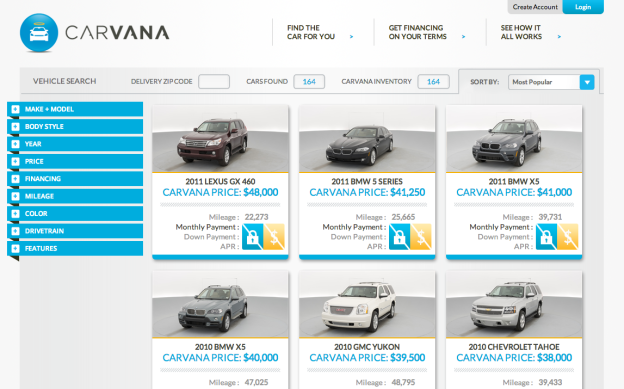
Let’s say you’re one of those folks who prefers to buy your gadgets on Amazon, your clothes through GILT, and everything else through, well, Amazon again. When it comes to small or medium-expense purchases, going online makes a lot of sense. But what about that second-largest purchase you’ll ever make — your next car?
Companies like Cars.com and AutoTrader have made shopping online for your car relatively simple, but in the end, you still have to pick up the phone and meet someone. eBay Motors takes that model a step further by allowing for the entire transaction to occur online, as long as you’re comfortable purchasing a car sight-unseen. A new Phoenix-based company is going the extra mile.
Online startup Carvana launched its first digital-to-driveway dealership in Atlanta. The concept is designed to allow shoppers the chance to do 100 percent of their vehicle search, financing and delivery arrangements online with an eBay-meets-Carmax kind of flavor.
Carvana’s used car team photographs each vehicle in the company’s inventory in their high-tech studio. The studio uses a series of high-resolution cameras both inside and out to make certain than any pits, scratches or stains are clearly highlighted for the shopper to see, leaving no question on the state of the car’s cosmetics.
Upon selecting a vehicle online, you’re then able to lock in your financing rates with a very slick tool that guarantees your price for five days. A few digital signatures later, and you can use an electronic check to seal the deal and place your down payment on the car. The final step is scheduling your delivery, which can be done at either your home or work address.
While the idea of buying a used car without seeing it seems a little unnerving to us, keep in mind that eBay Motors sells thousands of cars every year with pretty great success. Add to that Carvana’s concierge delivery service and 7-day money-back guarantee, and you’re essentially just test-driving a car for a week with a down payment as your deposit. If you’re not happy, they’ll take the car back and refund your check. That said, we’re feeling more comfortable already.
Carvana’s business model seems like a pretty cool one to us, and their website is one of the most attractive car shopping tools we’ve ever experienced. While the company’s pilot location only serves within a 250-mile radius of Atlanta, there are several more locations currently in the works.
We’d recommend taking a look at Carvana’s website. Then, let us know if you think it’s avant-garde or something to be short-lived in the comments below.


